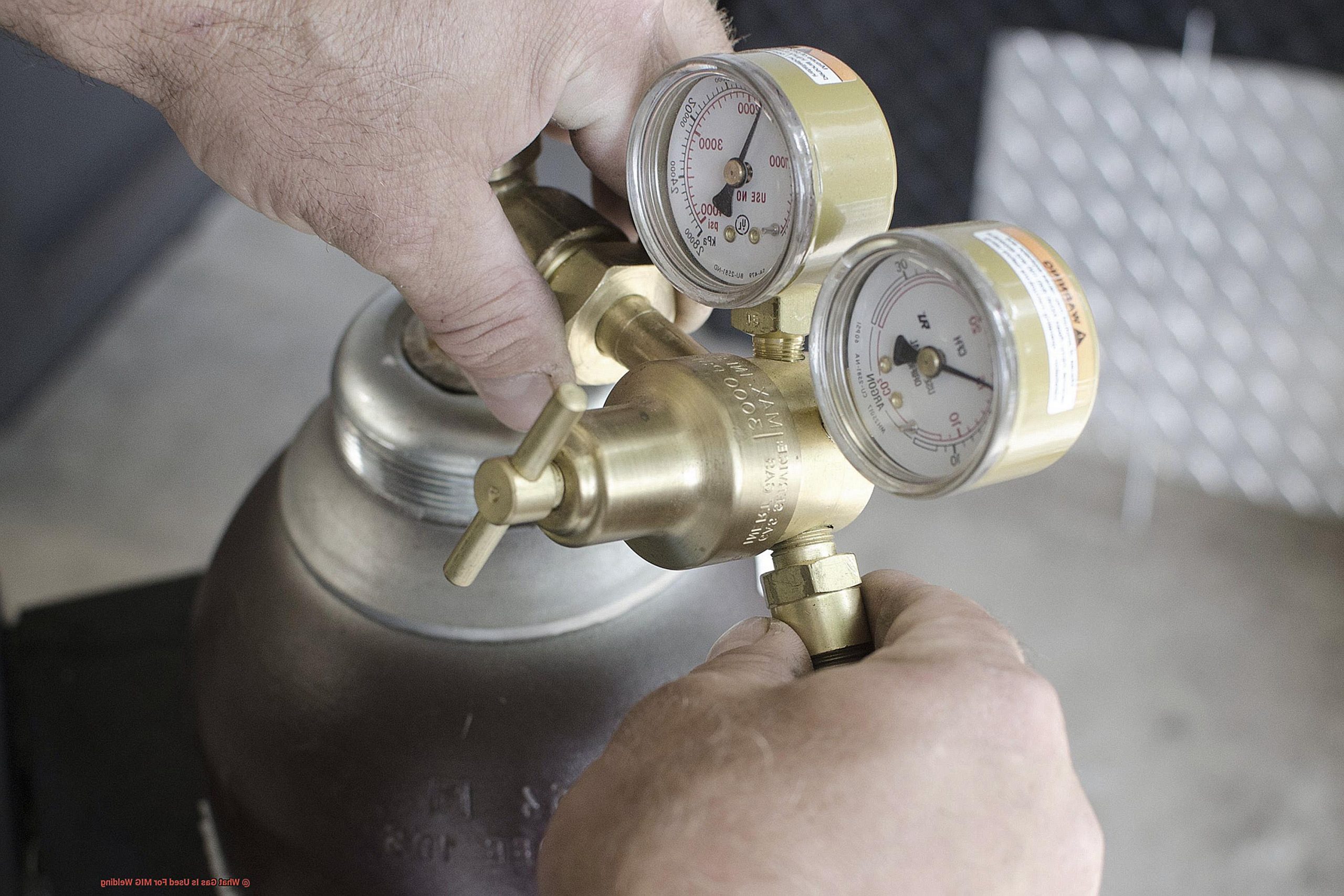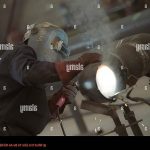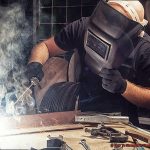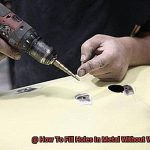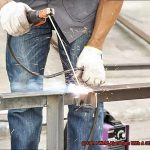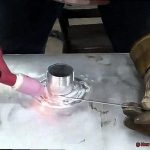Do you want to know the secret behind high-quality welding? It all comes down to the gas used in MIG welding. This technique is a top choice for fusing metal together, but without the right gas, your results could be subpar.
MIG welding requires a shielding gas to protect the weld from air exposure. This not only ensures exceptional welding but also prevents oxidation and porosity, two factors that can weaken your final product. The type of gas used in MIG welding varies depending on the material being welded. However, argon, carbon dioxide, and helium are among the most commonly used gases.
Argon is often preferred when working with non-ferrous materials like aluminum and copper due to its consistent shielding properties. Carbon dioxide is an affordable option that’s popular when welding mild steel. Helium is a go-to choice for thick metal plates as it provides higher heat input.
But it’s not just about using any old gas. The flow rate, mixture, and temperature can all impact your final result. That’s why it’s crucial to work with an experienced welder who knows how to select and use the right gas for each job.
So next time you’re marveling at a beautifully crafted piece of metalwork, take a moment to appreciate the role played by the gas used in MIG welding – an essential ingredient in creating stunning works of art.
What is MIG Welding?
Contents
MIG welding, also known as Gas Metal Arc Welding (GMAW), is a welding technique that artfully fuses two pieces of metal together. This process uses a continuous wire electrode that is fed into the weld pool while being shielded by an inert gas. This gas creates a protective barrier that shields the weld from atmospheric gases, ensuring the quality of the final product.
The most commonly used gas in MIG welding is a mixture of argon and carbon dioxide, which provides excellent penetration and minimizes spatter. This mixture is ideal for welding thicker metals such as steel. For non-ferrous metals like aluminum, pure argon is commonly used, but it requires adjustments to the welding parameters due to its lower heat input.
Aside from argon and carbon dioxide, other gases like helium and oxygen can also be used depending on the type of metal being welded and desired outcome. Helium can be added to increase penetration when welding thicker metals.
MIG welding is an incredibly versatile and efficient way to join metals together, making it a popular choice in various industries such as manufacturing, automotive repair, and construction. It is easy to learn and can be used on a wide range of materials including stainless steel, aluminum, and mild steel.
Choosing the right gas for MIG welding depends on several factors such as the type of metal being welded, its thickness, and the desired weld characteristics. It’s important to consult with a welding expert or refer to the manufacturer’s recommendations to determine the appropriate gas mixture for your specific welding needs.
Overall, MIG welding is an excellent choice for those looking for a reliable and efficient way to join metals together. With proper technique and equipment, high-quality welds can be produced that are strong and durable.
What Gas Is Used For MIG Welding?
MIG welding, or Metal Inert Gas welding, is an effective technique that utilizes a wire electrode shielded by an inert gas. But what role does the gas play?
The gas used in MIG welding is crucial because it acts as a shield to protect the molten metal from reacting with oxygen and nitrogen. This helps prevent defects in the weld and ensures a clean, strong final product. Argon is the most commonly used gas for MIG welding due to its non-reactive properties and low ionization potential. This means it requires little energy to ionize the gas, making it easy to start and maintain an arc.
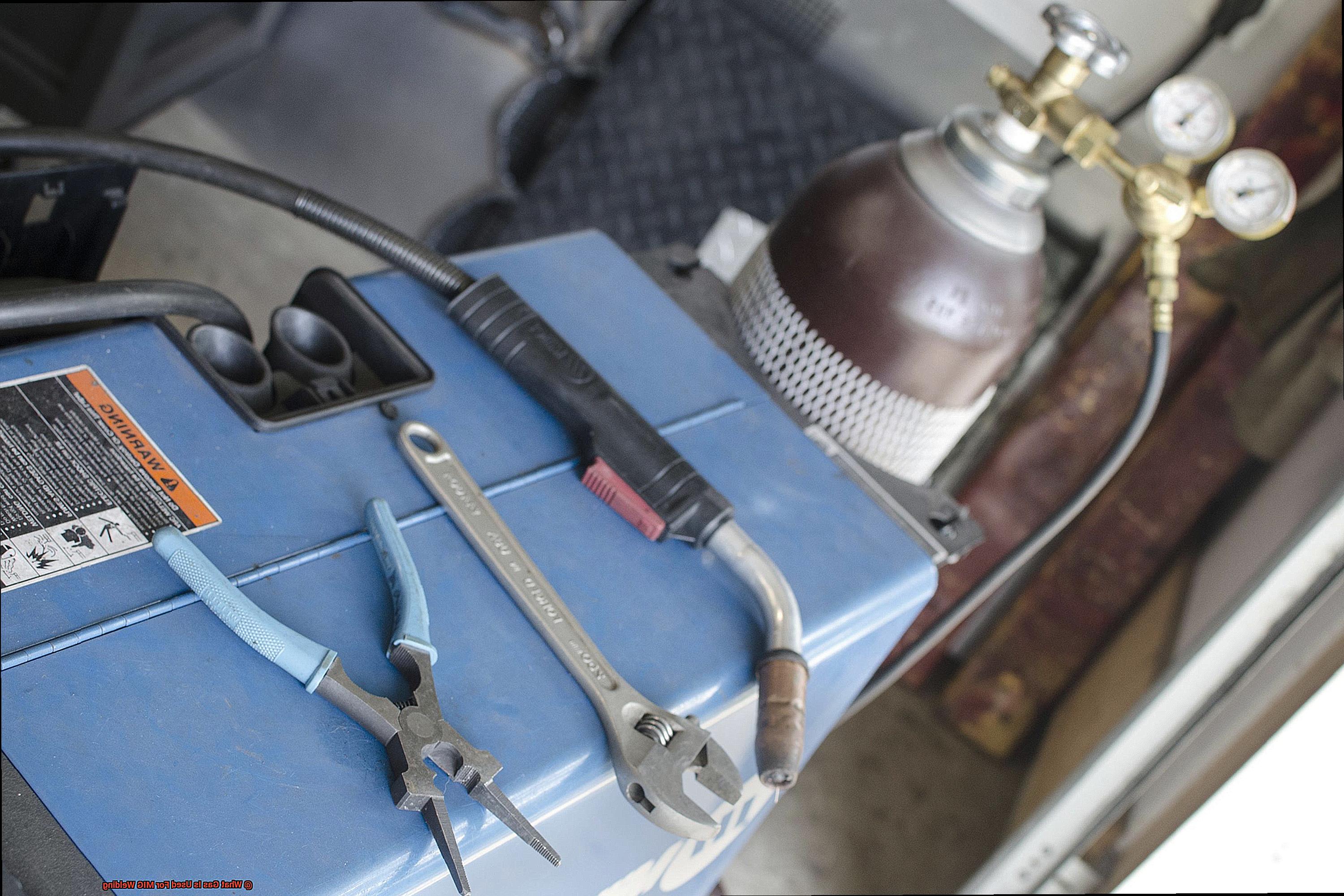
But argon isn’t the only option. Carbon dioxide (CO2) is less expensive than argon and can create deeper penetration than argon once the arc is established. However, CO2 can be harder to start and maintain an arc due to its higher ionization potential.
To get the best of both worlds, many welders use a mixture of argon and CO2 called C2With 75% argon and 25% CO2, this blend offers a balance between good arc stability and weld puddle control from argon, and increased penetration and weld speed from CO2.
For specific welding applications, other gases like helium or oxygen can be added to the mixture. Helium can increase heat input and penetration, while oxygen can improve arc stability and increase travel speed.
Argon and Carbon Dioxide Mixture for Steel Welding
Look no further than the versatile argon and carbon dioxide mixture, also known as C2This blend contains 25% carbon dioxide and 75% argon, making it an ideal choice for both short-circuiting and spray transfer welding.
One of the key benefits of using C25 for steel welding is its ability to create deep weld penetration. Thanks to the high percentage of carbon dioxide in the mixture, it can effortlessly penetrate the base metal. Additionally, the high amount of argon provides good arc stability, allowing for greater control over the welding process.
C25 is perfect for thicker materials as it helps produce smoother welds with less spatter. Moreover, this gas mixture is suitable for both single-pass and multi-pass welding applications, making it an excellent choice for a wide range of projects.
C25 is also an economical option when compared to other gas blends such as pure argon or helium. Additionally, this blend has a longer shelf life than pure carbon dioxide, which can absorb moisture over time and negatively impact weld quality.
It’s important to note that C25 is best suited for welding mild steel, low alloy steel, and stainless steel. However, it’s not recommended for welding aluminum or other non-ferrous metals.
Pure Argon for Non-Ferrous Metals
Look no further than pure argon gas. This gas is an inert one and does not react with the metal being welded, making it an ideal choice for this application.
Using pure argon for MIG welding non-ferrous metals can be challenging, but it remains a popular choice among welders for its superior shielding properties. The pure argon gas provides excellent protection against atmospheric contamination and produces a clean, consistent weld bead. With the correct voltage and amperage settings, high-quality welds can be achieved on even the most reactive metals.
It’s noteworthy that using pure argon for MIG welding non-ferrous metals requires a higher voltage and amperage setting than when using a mixed gas. This is because the ionization potential of pure argon is lower than that of mixed gases. As a result, it requires a higher voltage to initiate an arc. Additionally, pure argon provides less thermal conductivity than mixed gases, which can lead to slower heat transfer and longer welding times.
Despite these challenges, pure argon remains an excellent choice for MIG welding non-ferrous metals due to its superior shielding properties. This makes it an ideal choice for welders who want to ensure high-quality welds on even the most reactive metals.
Other Gases Used in MIG Welding
While argon and CO2 are commonly used, there are other gases that can take your welding game to the next level. Let’s explore the various gases that can be used for MIG welding and their unique advantages.
First on our list is helium. This gas packs a punch when combined with argon, as it produces a hotter arc and deeper penetration. This makes it ideal for welding thicker materials or when a stronger weld is required. With helium, tackling those challenging welding projects will seem like a breeze.
Next up is nitrogen, an inert gas that can displace oxygen during the welding process, making it an excellent choice for materials like stainless steel or aluminum that are susceptible to oxidation. Using nitrogen as a shielding gas can prevent oxidation and lead to a higher quality weld, ensuring your project looks sleek and professional.
Some welders prefer using a combination of argon, CO2, and oxygen for their MIG welding process. This mixture can increase heat input and improve penetration, resulting in superior welds overall. However, it’s crucial to note that too much oxygen in the mix can cause porosity in the welds.
For specialty applications such as brazing or soldering, propane or butane may be used. It’s essential to consult with a professional or refer to manufacturer guidelines when choosing a gas for your MIG welding application to ensure optimal results.
Factors to Consider When Choosing the Right Gas for MIG Welding
Choosing the right gas is crucial for achieving high-quality and consistent welds. With so many gas options available, it can be overwhelming to decide which one to use. But fear not, we’ve got you covered. In this article, we’ll explore the seven key factors to consider when selecting the right gas for MIG welding.
Firstly, the type of metal being welded is the most important factor in determining the appropriate gas mixture. Different metals require different gases to achieve optimal results. For instance, when welding mild steel, a gas mixture of 75% argon and 25% carbon dioxide is commonly used. This mixture provides excellent penetration and stability to the arc. On the other hand, when welding stainless steel, a gas mixture of 98% argon and 2% oxygen is recommended to produce a clean and shiny weld.
Secondly, the desired weld appearance is another critical factor when selecting the right gas for MIG welding. If you want to achieve a spatter-free weld with reduced post-weld clean-up, then a gas mixture with higher levels of argon is recommended. Pure argon or an argon-rich mixture can help reduce spatter production and improve weld bead appearance.
Thirdly, the welding process being used also plays a significant role in determining the appropriate gas mixture for MIG welding. When using pulsed MIG welding to weld thin metals, a gas mixture with higher levels of helium is recommended. The addition of helium helps increase heat input and produces better penetration on thinner materials.
Fourthly, the thickness of the metal being welded is another crucial factor that affects gas selection. For thicker metals, a higher percentage of carbon dioxide in the gas mixture is recommended as it increases penetration and weld size.
Fifthly, welding position also influences gas selection. If you’re welding overhead or vertically upwards, then you’ll need a gas mixture that provides excellent arc stability and penetration. A gas mixture with higher levels of argon or helium is generally recommended for these positions.
Sixthly, the welding environment is an essential consideration when selecting the right gas for MIG welding. If you’re working in a windy or drafty environment, then a gas mixture with higher levels of carbon dioxide is recommended to maintain a stable arc.
Lastly, safety is always a top priority. It’s crucial to select a gas mixture that is safe for both the welder and the environment.
TVM969GD44w” >
Conclusion
In conclusion, the gas used for MIG welding is a critical component in achieving top-notch and consistent welds. The type of gas selected depends on various factors such as the material’s thickness, the metal being welded, and desired weld characteristics. Argon, carbon dioxide, and helium are some of the most commonly used gases in MIG welding.
Argon is an ideal choice for non-ferrous metals like aluminum and copper due to its consistent shielding properties. Carbon dioxide is a popular option when welding mild steel because it’s cost-effective. Meanwhile, helium is perfect for thick metal plates since it provides higher heat input.
However, choosing any old gas won’t cut it. The flow rate, mixture, and temperature can all impact your final result. That’s why partnering with an experienced welder who knows how to select and use the right gas for each job is crucial.
Other gases such as nitrogen and oxygen can also be used depending on the metal type being welded and desired outcome. It’s essential to consider several factors when selecting the right gas for MIG welding, including metal type, desired appearance, welding process, thickness of metal, welding position, environment, and safety.
Overall, MIG welding is an excellent choice for those seeking a reliable and efficient way to join metals together.
